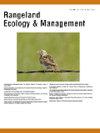从鸟类到生物群落:探索鼠尾草行动在保护和发展鼠尾草核心区中的作用
IF 2.4
3区 环境科学与生态学
Q2 ECOLOGY
引用次数: 0
摘要
十五年来,由自然资源保护局 (NRCS) 管理的 "鼠尾草倡议"(SGI)一直是美国西部私人牧场自愿保护农业法案投资的主要交付机制。SGI 与机构间将保护范围从鼠尾草扩展到整个鼠尾草生物群落的努力相一致,通过解决破坏工作地恢复力的复杂生态系统问题,将重点放在有利于野生动物的保护行动上。最近开发的 "鼠尾草保护设计"(Sagebrush Conservation Design,SCD)提供了一个共同框架,用于协调众多合作伙伴为拯救生物群落中仅存的完整鼠尾草生态系统所做的努力。在本论坛论文中,我们将探讨 SGI 私人土地战略保护与 SCD 相关的历史,并思考如何利用 SCD 改善未来的保护工作。从 2010 年到 2022 年,NRCS 通过 SGI 为地役权、针叶树移除和一年生入侵草管理提供了 4.23 亿美元的农业法案资金,其共同目标是捍卫和发展核心区,其中大多数 SGI 行动发生在核心区(6-14%)和发展区(另外 40-57%)。SCD 的生态完整性评分表明,由 SGI 资助的针叶林移除行动扭转(7 次)或阻止(2 次)了九个重点景观中针叶林侵占造成的退化。在恢复核心和生长方面,集中移除针叶树的效果要比分散、孤立处理的 5% 效果高出 20%。我们的评估还表明,入侵的一年生植物正在破坏最初的 SGI 投资的完整性,因此需要更多的关注来保护和增长核心。考虑到核心区与鼠尾草和依赖鼠尾草的鸣禽的生物学相关性,采用 SCD 可以帮助 SGI 更有效地实现预期的野生动物成果。本文章由计算机程序翻译,如有差异,请以英文原文为准。
From a Bird to a Biome: Exploring the Sage Grouse Initiative's Role in Defending and Growing Sagebrush Core Areas
The Sage Grouse Initiative (SGI) administered by the Natural Resources Conservation Service (NRCS) has served as a primary delivery mechanism for Farm Bill investments in voluntary conservation of private rangelands in the western U.S. for fifteen years. Consistent with interagency efforts to extend conservation beyond sage-grouse to the entire sagebrush biome, the SGI has evolved to focus on conservation actions that benefit wildlife by addressing complex ecosystem problems undermining the resilience of working lands. Recent development of the Sagebrush Conservation Design (SCD) provides a common framework to coordinate the efforts of many partners invested in saving the biome's last remaining intact sagebrush ecosystems. In this forum paper, we explore the history of the SGI's strategic conservation on private lands relative to the SCD and reflect on how it could be used to improve future conservation delivery. From 2010 to 2022, NRCS contributed $423USD million in Farm Bill funds through SGI to easements, conifer removal, and invasive annual grass management with the shared goal of defending and growing Core, with most SGI actions occurring in Core (6–14%) and Growth (an additional 40–57%). The SCD's ecological integrity scores suggest that SGI-funded conifer removal has either reversed (7) or halted (2) the degradation attributable to conifer encroachment in nine focal landscapes. Concentrating conifer removals together was 20% more effective at restoring Core and Growth than the 5% gains realized among scattered, isolated treatments. Our evaluation also shows that invasive annuals are undermining the integrity of initial SGI investments and warrant more attention to defend and grow Core. Embracing the SCD could help the SGI more effectively achieve desired wildlife outcomes given the biological relevance of Cores to sage-grouse and sagebrush-obligate songbirds.
求助全文
通过发布文献求助,成功后即可免费获取论文全文。
去求助
来源期刊

Rangeland Ecology & Management
农林科学-环境科学
CiteScore
4.60
自引率
13.00%
发文量
87
审稿时长
12-24 weeks
期刊介绍:
Rangeland Ecology & Management publishes all topics-including ecology, management, socioeconomic and policy-pertaining to global rangelands. The journal''s mission is to inform academics, ecosystem managers and policy makers of science-based information to promote sound rangeland stewardship. Author submissions are published in five manuscript categories: original research papers, high-profile forum topics, concept syntheses, as well as research and technical notes.
Rangelands represent approximately 50% of the Earth''s land area and provision multiple ecosystem services for large human populations. This expansive and diverse land area functions as coupled human-ecological systems. Knowledge of both social and biophysical system components and their interactions represent the foundation for informed rangeland stewardship. Rangeland Ecology & Management uniquely integrates information from multiple system components to address current and pending challenges confronting global rangelands.
 求助内容:
求助内容: 应助结果提醒方式:
应助结果提醒方式:


